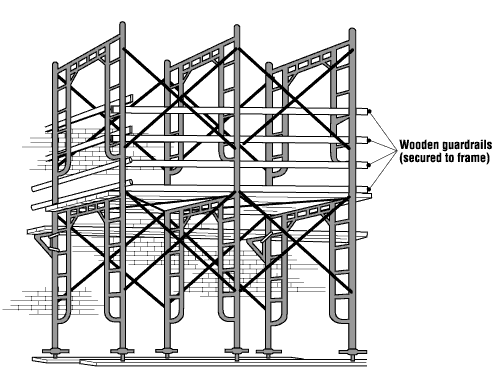Platforms - Frame Scaffold Set Up
On this page
What should I know about the assembly of frame scaffold?
Back to top- Make sure you are trained properly to set up scaffolding.
- Check location for:
- ground conditions
- overhead wires
- obstructions
- changes in surface elevation
- tie-in problems
- Inspect frames, braces and all other components for damage, bends and excessive rust or wear.
- Use a safety harness which is tied off to the scaffold, building or lifeline. Refer to OSH Answers Safety Belts, Harnesses and Lanyards for more information.
- Assemble frame scaffolds with one other person so that one person is on the scaffold and one is passing materials from the ground.
- Check for squareness and alignment of all scaffold parts.
- Remove debris and mud from the setup area, and level the ground before placing the staging legs.
- Setup the staging legs on a stable, solid base. Use mudsills when scaffolding is erected on soil.
- Use appropriate mud sills 50 x 250 mm (e.g., 2 x 10 ft planks) that are continuous under at least two support feet. Where possible, the sill should extend at least 600 mm (2 ft) beyond the scaffold feet at the end.
- Nail or screw the base plates to the mudsills.
- Use jackscrews to eliminate hazards created by temporarily jacking up the erected scaffold to add shims when sections settle or are not level.
- Inspect locking devices frequently.
- Make sure all sections of the first level are level and square.
- Install ladders as the erection proceeds. When scaffolds are to be in place for an extended period, install a stairway. Ladders must extend 1 m (3 ft) above the platform and be tied securely to the staging.
- Fasten all braces and guardrails securely. Make sure all cross bracing fits and locks onto each post in every section.
- Install all of the guardrails that are required: top, mid and toe. Requirements will vary depending on the materials used, and on the the legislation that applies in your area.
- Inspect planks before use. Check the weight the planks will have to carry, including the weight of the crew, tools and materials.
- Complete platform fully at each working level before assembling the next level.
- Secure the scaffolding to the adjacent building structure as specified in the legislation that applies in your area.
- Assemble all equipment according to manufacturer's specifications or engineer's design.
What should I not do when assembling scaffold?
Back to top- Do not mix frames and parts from different manufacturers.
- Do not use nails or other devices in the place of proper retention parts as recommended by the manufacturer.
- Do not substitute concrete blocks, bricks or scrap lumber for a proper mud sill base, plates and jackscrews.
- Do not overextend jackscrews.
- Do not use ladders or makeshift devices on top of scaffolds to increase the height.
- Do not use the same planks for sills as you do for platform bases.
- Do not rig braces that do not fit properly.
- Do not use cross-braces as guardrails.
- Do not use scaffold frames to climb up to work platforms.

What should I know when dismantling scaffold?
Back to top- Make sure the structure will remain stable at all times.
- Clear platform of all materials and debris before dismantling.
- Proceed in the reverse order of erection.
- Dismantle each tier completely before starting on the one below.
- Work from full platform decks while removing braces and frames.
- Remove jammed or rusted components with caution. Tugging or pulling on stuck parts often causes a loss of balance. Wear a safety harness and lanyard which is properly tied off.
- Do not throw or drop boards or parts from heights.
- Check and maintain all scaffold parts. Repair or discard all damaged pieces immediately.
- Lubricate moving parts of all fittings.
- Fact sheet last revised: 2017-11-01
